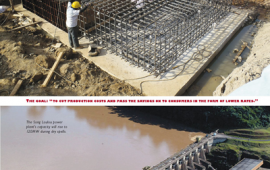Energy Power: the mega-project

The news from Washington on 27 March that the World Bank granted a $132-million (€100 million) interest-free loan to help build the Lom Pangar hydroelectric dam in eastern Cameroon nearly had people dancing in the streets. Why? The project’s impact. “Africa’s power shortage holds back the continent’s growth and increases poverty,” says Obiageli K. Ezekwesili, the bank’s vice-president for Africa. “That’s especially true in Cameroon, where many communities lack access to power even though the country has sub-Saharan Africa’s third-biggest hydroelectric potential.” The programme includes building a dam and a six-billion-m3 reservoir that will increase the River Sanaga’s regularisation capacity and boost the output capacity of existing hydroelectric plants (Song Loulou, Edéa, Nachtigal, etc.) or future ones by 120 megawatts (MW) during low-water periods. A 30MW power plant at the foot of a dam intended to supply the East province with power is in the planning stages. A partnership between the African Development Bank (ADB), Central African States Development Bank (CASDB), European Investment Bank (EIB), Agence française de développement (AFD) and Cameroonian government is funding the 220-billion-FCFA (€335 million) Lom Pangar hydroelectric project. Meanwhile, the China Exim Bank is financing 85% and the Cameroonian State 15% of another major scheme, the hydroelectric development at Mekin, whose estimated cost is put at 25 billion FCFA (€38 million). Now under way, the programme includes a dam, a 105-million-m3 reservoir, a 15MW power plant and a 63kV high-voltage line connected to the southern grid (RIS). The China Exim Bank has loaned 243 billion FCFA (€370 million) for the 286-billion-FCFA (€436 million), 201MW Memve’ele Dam, which is under construction; some of the electricity produced will be exported to the sub-region. The facility will generate and inject power into the national and sub-regional grid. In addition to its 43 billion-FCFA (€65.5 million) share of the project, the State has already invested 14 billion (€21 million) in building the site’s access roads, while the ADB is lending 58 billion (€88 million) to finance the powertransport facilities and over 4.2 billion (€6.4 million) to build the Ebolowa transforming station.
Like those partnerships, seven other institutions, including Cameroonian banks, pooled their financing in early 2012 to provide the 130 billion FCFA (€198 million) necessary to build the Kribi gas-fired power plant, which should inject 216MW into the nation’s power grid by January 2013. The total estimated investment is put at 172.6 billion FCFA (€263 million). Power and Water Minister Basile Atangana Kouna says that, in addition to the government’s many guarantees to lenders, the Kribi Power Development Company, 44%-owned by the State, will fund 25% of the amount. Lastly, in December the Société nationale des hydrocarbures should start delivering gas to the site, which will be up and running in the first quarter of 2013.
EMERGENCY STEPS While waiting for the programmes to come online, new thermal power plants have been built in four of the cities most affected by power rationing: Bamenda, Ebolowa, Mbalmayo and Yaoundé. The operation, which is part of the emergency thermal power programme and directly run by the government, will add around 100MW to the country’s southern grid. At the same time, the public-private utility AES Sonel has developed major thermal plants in Limbé (85MW) and Yassa Dibamba (86MW) since it started operating in Cameroon. Building power infrastructure in a country like Cameroon is a daunting task. That is why the State has become involved, setting up a new public company in 2006, the Electricity Development Corporation (EDC), which will design, run and manage all the programmes. The goal: “to cut production costs and pass the savings on to consumers in the form of lower rates,” says CEO Théodore Nsangou. That is another reason for reforming the industry. Last year a new law introduced the idea of the independent producer, allowing industrial groups to autonomously generate power, thereby fostering competition. At this point, new operators can develop and operate power generation and transport activities in order to meet manufacturers’ or institutions’ needs.
By François BAMBOU